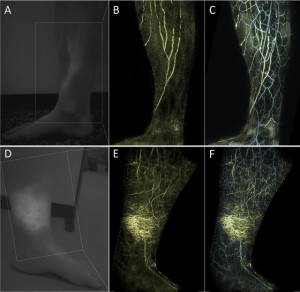<Title:> Visualization of Lymphatic Vessels Using Photoacoustic Imaging
<Author(s):> Hiroki Kajita, Yushi Suzuki, Hisashi Sakuma, Nobuaki Imanishi, Tetsuya Tsuji, Masahiro Jinzaki, Sadakazu Aiso, Kazuo Kishi
<Abstract:> Lymphedema occurs when interstitial fluid and fibroadipose tissues accumulate abnormally because of decreased drainage of lymphatic fluid as a result of injury, infection, or congenital abnormalities of the lymphatic system drainage pathway. An accurate anatomical map of the lymphatic vasculature is needed not only for understanding the pathophysiology of lymphedema but also for surgical planning. However, because of their limited spatial resolution, no imaging modalities are currently able to noninvasively provide a clear visualization of the lymphatic vessels. Photoacoustic imaging is an emerging medical imaging technique that provides unique scalability of optical resolution and acoustic depth of penetration. Moreover, light-absorbing biomolecules, including oxy- and deoxyhemoglobin, lipids, water, and melanin, can be imaged. Using exogenous contrast agents that are taken up by lymphatic vessels, e.g., indocyanine green, photoacoustic lymphangiography, which has a higher spatial resolution than previous imaging modalities, is possible. Using a new prototype of a photoacoustic imaging system with a wide field of view developed by a Japanese research group, high-resolution three-dimensional structural information of the vasculatures was successfully obtained over a large area in both healthy and lymphedematous extremities. Anatomical information on the lymphatic vessels and adjacent veins provided by photoacoustic lymphangiography is helpful for the management of lymphedema. In particular, such knowledge will facilitate the planning of microsurgical lymphaticovenular anastomoses to bypass the excess fluid component by joining with the circulatory system peripherally. Although challenges remain to establish its implementation in clinical practice, photoacoustic lymphangiography may contribute to improved treatments for lymphedema patients in the near future.
<Keywords:> photoacoustic techniques, lymphatic vessels, lymphedema, indocyanine green
<URL:> https://www.jstage.jst.go.jp/article/kjm/advpub/0/advpub_2020-0010-OA/_html


![Incidence, Clinical Characteristics, and Long-term Outcome of the Dilated Phase of Hypertrophic Cardiomyopathy [Published online in advanced , by J-STAGE]](http://kjm.pupu.jp/blog/wp-content/uploads/2018/12/2018-0004-OA-100x100.jpg)
![Mechanisms of iPS cell generation and beyond [Published online Keio J Med, 66, 14-14, by J-STAGE]](http://kjm.pupu.jp/blog/wp-content/uploads/2017/03/66-002-ABST-100x100.jpg)
![Multiple Mutations within Individual Oncogenes: Examples and Clinical Implications [Published online Keio J Med, 72, 88-92, by J-STAGE]](http://kjm.pupu.jp/blog/wp-content/uploads/2023/09/2022-0026-OA-100x100.jpg)
![Differential X Chromosome Inactivation Patterns during the Propagation of Human Induced Pluripotent Stem Cells [Published online Keio J Med, 66, 1-8, by J-STAGE]](http://kjm.pupu.jp/blog/wp-content/uploads/2017/03/2016-0015-OA-100x100.jpg)
![Human Amniotic Fluid Stem Cells: Therapeutic Potential for Perinatal Patients with Intractable Neurological Disease [Published online in advanced , by J-STAGE]](http://kjm.pupu.jp/blog/wp-content/uploads/2018/03/2017-0019-IR-100x100.jpg)
![Food Protein-induced Enterocolitis Syndrome [Published online Keio J Med, 72, 1-10, by J-STAGE]](http://kjm.pupu.jp/blog/wp-content/uploads/2023/03/2022-0016-IR-100x100.jpg)
![Vitamin D Deficiency with High Intact PTH Levels isMore Common in Younger than in Older Women:A Study of Women Aged 39 64 Years [Published online in advanced , by J-STAGE]](http://kjm.pupu.jp/blog/wp-content/uploads/2016/02/2015-0010-OA-100x100.jpg)
![Reoperative Aortic Valve Replacement for Structural Valve Deterioration through a Lower Hemisternotomy after a Previous Bentall Procedure in a Patient with Tracheostomy [Published online in advanced , by J-STAGE]](http://kjm.pupu.jp/blog/wp-content/uploads/2023/01/2022-0009-CR-100x100.jpg)
![<i>Listeria monocytogenes</i> Meningitis Complicating Rotavirus Gastroenteritis in an Immunocompetent Child [Published online in advanced , by J-STAGE]](http://kjm.pupu.jp/blog/wp-content/uploads/2017/04/2016-0007-CR-100x100.jpg)
![Overview of the COVID-19 Pandemic in Japan: Public Health Perspectives in the first half of 2020 [Published online Keio J Med, 70, 73-81, by J-STAGE]](http://kjm.pupu.jp/blog/wp-content/uploads/2021/12/kjm-covid19-02-100x100.jpg)